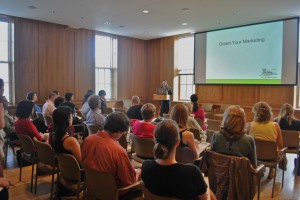 Thanks to Emily Kanter at the Sustainable Business Leader Program & CEA‘s Lilah Glick, a group of Cambridge’s small business leaders were able to come together for a Green Marketing workshop on June 17th, led by Leah Bloom, the media-proclaimed “green business guru.”
Thanks to Emily Kanter at the Sustainable Business Leader Program & CEA‘s Lilah Glick, a group of Cambridge’s small business leaders were able to come together for a Green Marketing workshop on June 17th, led by Leah Bloom, the media-proclaimed “green business guru.”
Continue reading
Category Archives: Business
Large corporations making large investments in renewable energy
 21st century green initiatives are sparking life in today’s economy. Particularly, there have been a few major investments in renewable energy technologies that have positively influenced the stock market. In recent news, ProLogis, a distribution warehouse provider has made a tremendous investment in solar rooftop implementation in Southern California totaling 11.1 megawatts But what impact is this type of investment really having on our planet and economy?
21st century green initiatives are sparking life in today’s economy. Particularly, there have been a few major investments in renewable energy technologies that have positively influenced the stock market. In recent news, ProLogis, a distribution warehouse provider has made a tremendous investment in solar rooftop implementation in Southern California totaling 11.1 megawatts But what impact is this type of investment really having on our planet and economy?
The master agreement between Southern California Edison (SCE) and ProLogis has positively influenced the company’s stock. The company is able to provide such power through the direct installation of over 4 square kilometers (1.6 square miles) of rooftop panels that will effectively power the entire facility. The project is considered to be “multi-phase,” and will be a progressive installations beginning with nearly ¼ square kilometers. ProLogis currently maintains solar projects on 32 buildings throughout France, Germany, Japan, Spain and the United States.
With large size and and flat roof structure of facilities such as Prologis’, installation of solar power is a natural solution to powering the facility, and obtaining added value from the structure. Vice President of renewable energy for ProLogis states “Our partnership with SCE works well for both parties—we have flat, available roof space and local construction management expertise in place to support the growth of SCE’s renewable energy program.” This is one such example of how electric companies are working with larger organizations to promote sustainability and renewable energy. FedEx is another, earlier adopter of similar systems.
Online service giant Google recently made their biggest renewable energy investment in history. With projects beginning back in 2007, Google has pursued sustainability and renewable energy efforts as wise business investments and as a natural extension of their unofficial motto “Don’t be evil.” On May 3rd a press release went out stating Google’s 38.8 million dollar investment in two North Dakota wind farms. “On Friday we made our first direct investment in a utility-scale renewable energy project—two wind farms that generate 169.5 megawatts of power, enough to power more than 55,000 homes.” Rick Needeham, (Google’s Green Business Operations Manager), wrote within that Google is greatly interested in discovering new opportunities to invest in renewable energy projects that really ”push the envelope.” With enough energy to power nearly 55,000 homes, Google is making a tremendous impact on sustainability for our planet.
With Google’s acquisition of wind turbines in North Dakota, they are able to produce nearly 170 MW of power. Combined, this is a whopping 194.6 MW of clean energy, driven to both business and residential. With lessened maintenance costs and new job openings, these investments are major players in the welfare of our economy as well. It’s with efforts from both energy and non-energy groups that we begin to see hope for the future of our planet.
Edited by Jerrad Pierce
World Fair Trade Day
 Tomorrow is World Fair Trade Day, and it will be observed at numerous progressive businesses around Boston. Specific event and promotion details will be posted tomorrow, but the overarching theme is a “fair trade crawl.” Visit a designated number of venues for a chance to win prizes; fairly traded of course!
Tomorrow is World Fair Trade Day, and it will be observed at numerous progressive businesses around Boston. Specific event and promotion details will be posted tomorrow, but the overarching theme is a “fair trade crawl.” Visit a designated number of venues for a chance to win prizes; fairly traded of course!
While you’re out peddling around to burn off all that ice cream, be sure to hit-up Fresh Pond Day and the SomerGreen Festival.
Gulf Oil Disaster
 By now, news of the catastrophic BP off-shore oil rig explosion in the Gulf, and now massive resulting oil leak, has circulated national and international press. Referred to as one of the worst environmental disasters on record, with an oil spill predicted to be double that of the Exxon Valdez in 1989: at a rate of 25,000 barrels a day, a total of 2.2 million gallons of oil spilled, if the well isn’t tapped; a process experts say can take up to three months. Ironically, this event couldn’t have occurred at a more inopportune time for the President, who just a month ago announced a halt on the longstanding off-shore drilling moratorium along the US Eastern seaboard in order to expand off-shore oil and natural gas exploration. Sadly, this type of horrific environmental disaster has happened time and time again, and will continue to happen as long as we continue to rely on fossil fuels for the majority of our energy supply. The more important question to ask is: when is enough enough?
By now, news of the catastrophic BP off-shore oil rig explosion in the Gulf, and now massive resulting oil leak, has circulated national and international press. Referred to as one of the worst environmental disasters on record, with an oil spill predicted to be double that of the Exxon Valdez in 1989: at a rate of 25,000 barrels a day, a total of 2.2 million gallons of oil spilled, if the well isn’t tapped; a process experts say can take up to three months. Ironically, this event couldn’t have occurred at a more inopportune time for the President, who just a month ago announced a halt on the longstanding off-shore drilling moratorium along the US Eastern seaboard in order to expand off-shore oil and natural gas exploration. Sadly, this type of horrific environmental disaster has happened time and time again, and will continue to happen as long as we continue to rely on fossil fuels for the majority of our energy supply. The more important question to ask is: when is enough enough?
Paul Krugman correlates the recent BP disaster to the start of the environmental movement in the 1970s, when pollution was physically visible much more so than it is today. While existing EPA regulations, a result of the 1970s environmental movement, helped to cap much of the visible pollution of that time, today Americans are, ironically, less aware of environmental damage because we rarely see it. Climate change is a perfect example. Clearly there are visible products of climate change: weather shifts, species eradication and impacts on habitat, but in reality, how often do we actually stop and see these impacts? The implications are so long-term it’s often hard to comprehend.
As for BP, the oil spill happened and we cannot undo the subsequent damage. We can, however, learn from this event and wake up this time around. We have the chance to shift to a clean energy future; we have the technology, the brain power and the interested institutes and Universities. We now need strong, unfaltering leadership. No longer can we rely on such dirty and dangerous methods of energy production – the damage surely out weights any benefit.
The Economics of Climate Change
 Looking past the exciting technical, legislative and community advancements made to address climate change over the last few years, lies the reality of whether we as a society will make the necessary changes in energy use, lifestyle choices and investment decisions in time to avoid the most catastrophic global warming scenarios.
Looking past the exciting technical, legislative and community advancements made to address climate change over the last few years, lies the reality of whether we as a society will make the necessary changes in energy use, lifestyle choices and investment decisions in time to avoid the most catastrophic global warming scenarios.
In last weekend’s New York Times, Nobel Prize-winning economist Paul Krugman examined the question that could fatally delay the steps necessary to reduce the impact of climate change. It’s the question that many of the people running our government and global corporations are now pondering, “Is it good for business?” 
Even when people accept the reality of climate change, there is some legitimate debate on how fast and how hard the truly negative effects of global warming will visit us. So Krugman quickly takes the argument past the philosophical diatribe conducted by climate deniers and examines first how business plans for any other crisis. He identifies the best and worse case economic effects on GDP if we make drastic cuts in CO2 emissions. As it turns out, the very worst that could happen is a 3% drop in GDP that would likely soon be made up through the manufacture and marketing of the technical solutions and products necessary to live in a low-carbon emissions world.
Krugman then makes an attempt to predict the impact on the world economy if the effects of global warming produce the disastrous changes in climate and weather patterns that scientists predict will come true by the middle of the century. Suffice to say, a 3% decline in GDP would be the least of our troubles.
Like me, it might take you a couple of days to get through the article and ponder the consequences of Krugman’s predictions. It’s well worth your time-both for how well it shines a light on the decision-making processes of our legislative and business leaders, and because the facts may come in handy for debating colleagues who believe ‘the business of America is business’.
Green GDP
 In a recent Earth Magazine article, and just in time for the 40th Anniversary of Earth Day, an interesting argument was made regarding so-called “Green GDP.” Garrett Groves and Michael Webber point out that in the United States, as well as in many developed nations, current economic measurements of GDP are intended to assess national income and wealth exchange using a pre-World War II model created by Simon Kuznets, a Nobel prize winning economist. Within this model, there is little room for the quantifiable benefits of preservation or conservation of natural resources, or for decreasing carbon emissions. This model also fails to account for waste and pollution. Instead, our economic system measures “success” purely through monetary growth, development and exploitation of the Earth’s natural resources.
In a recent Earth Magazine article, and just in time for the 40th Anniversary of Earth Day, an interesting argument was made regarding so-called “Green GDP.” Garrett Groves and Michael Webber point out that in the United States, as well as in many developed nations, current economic measurements of GDP are intended to assess national income and wealth exchange using a pre-World War II model created by Simon Kuznets, a Nobel prize winning economist. Within this model, there is little room for the quantifiable benefits of preservation or conservation of natural resources, or for decreasing carbon emissions. This model also fails to account for waste and pollution. Instead, our economic system measures “success” purely through monetary growth, development and exploitation of the Earth’s natural resources.
Clearly, given climate change and our ever-increasing global demand for energy and natural resources, there is a serious and urgent need to re-evaluate economic definitions of prosperity and gain. To do this, a new indicator would need to be developed, one that reflected both economic prosperity and ecological health. Many international conferences have addressed this exact question, starting with the Rio 1992 Earth Summit. This discussion continues through talks in Kyoto, Johannesburg, Montreal, Copenhagen and soon, Cancun.
Unfortunately, there has been much political debate and little focused action with regard to a unified economic environmental measurement. Some economics argue that to do so would require privatizing the “commons”—or shared public goods such as atmosphere, ocean, and fresh water. A similar argument was famously discussed by Garrett Hardin in 1968. Others argue that the developing carbon “market” will be pivotal in defining further environmental economic measurements of its kind. One thing is certain: environmental economics must play a key role in public policy if we want to sustain a healthy planet for generations to come.
Cleaning up New York’s Gowanus Canal
 According to the NYTimes, the EPA announced that it will designate the Gowanus Canal in Brooklyn, one of the most contaminated waterways in the nation, a Superfund site. This designation paves the way for a federally-funded clean up process of decades of pollution; the 1.8 mile canal was shown to have pesticide pollution as well as PCB cancer-causing pollution. The EPA estimated that the cleanup would last 10 to 12 years and cost $300 million to $500 million. Interestingly, the Bloomberg Administration was not pleased with this news. The Administration argued that the designation could spark legal battles with polluters, defer completion of cleanup and dissuade construction by developers deterred by the stigma of a Superfund label.
According to the NYTimes, the EPA announced that it will designate the Gowanus Canal in Brooklyn, one of the most contaminated waterways in the nation, a Superfund site. This designation paves the way for a federally-funded clean up process of decades of pollution; the 1.8 mile canal was shown to have pesticide pollution as well as PCB cancer-causing pollution. The EPA estimated that the cleanup would last 10 to 12 years and cost $300 million to $500 million. Interestingly, the Bloomberg Administration was not pleased with this news. The Administration argued that the designation could spark legal battles with polluters, defer completion of cleanup and dissuade construction by developers deterred by the stigma of a Superfund label.
 The city instead envisioned a residential and commercial development project along the canal and supported voluntary cleanup measures by polluters. To establish these new residential areas, the city planned to hire the Army Corps of Engineers in a separate federal funding bid, but by doing so would not secure funding as well as with a Superfund designation. Critics also claimed the plan would complicate cleanup given the involvement of both the Army Corps of Engineers and the EPA. For those of you in the NYC area who are interested to learn more, the EPA plans to discuss next steps regarding the canal at a public meeting with neighborhood residents and other stakeholders on Thursday night at Public School 58 on Smith Street in Brooklyn.
The city instead envisioned a residential and commercial development project along the canal and supported voluntary cleanup measures by polluters. To establish these new residential areas, the city planned to hire the Army Corps of Engineers in a separate federal funding bid, but by doing so would not secure funding as well as with a Superfund designation. Critics also claimed the plan would complicate cleanup given the involvement of both the Army Corps of Engineers and the EPA. For those of you in the NYC area who are interested to learn more, the EPA plans to discuss next steps regarding the canal at a public meeting with neighborhood residents and other stakeholders on Thursday night at Public School 58 on Smith Street in Brooklyn.
The Cost of Business
According to a recent United Nations report, that’s being complied by Trucost, the world’s top 3,000 companies cause $2.2 trillion in environmental damage per year1. The report is said to include all 500 companies on Standard & Poor’s list of the largest publicly traded companies in the United States. Richard Mattison, the chief operating officer of Trucost, commented that the report not only examined company impacts but also goods and services, greenhouse gas emissions, local pollutions, particulate emissions, and use of natural resources like water and timber. While the aim of the report is to bring light to environmental business ethics, it’s also telling how complicated such reporting can become: many US companies do business and manufacture products globally making regulation, evaluation and monitoring a challenge. Nonetheless, Mr. Mattison notes that the intent of the report is to capture the attention of investors and educate those who want to affect positive environmental change through business decisions. He goes on to say that, one that of the things investors can do is engage with companies in a collaborative way. Seeing as we live in a global society heavily influenced by the corporate model, there may be no other immediate solution to meeting the demands of consumers and the demands of our planet.
1. By comparison, the gross world product is on the order of $50 trillion, and in 1997 ecosystem services were valued at $33 trillion; $44,000,000,000,000 in 2009 dollars.
Beyond Petroleum?
Given the monopolistic and powerful positions adopted by the oil companies since the beginning of the modern oil age in the nineteenth century, it is almost inevitable that their entry into the renewable arena will not be without problems. — ScienceBlog.com
Hot air
Back in July T. Boone Pickens announced a quartering of his mega-wind farm project. The project has essentially been scrapped due to continuing issues with access to transmission lines, as Mr. Pickens downplays wind in his wind+natural gas “plan.” The remaining order with GE has been halved to three hundred odd turbines, whose future home is expected to be relocated from the Texas panhandle to Canada or Montana. Continue reading



